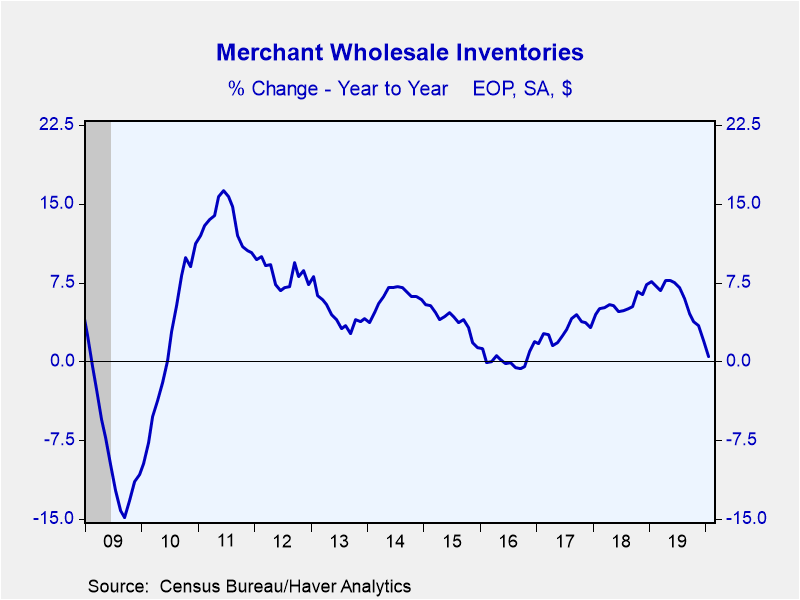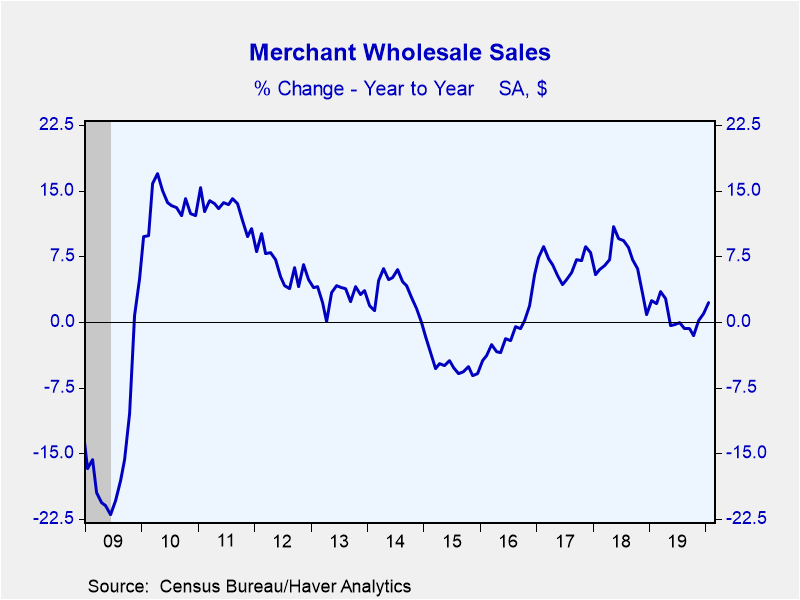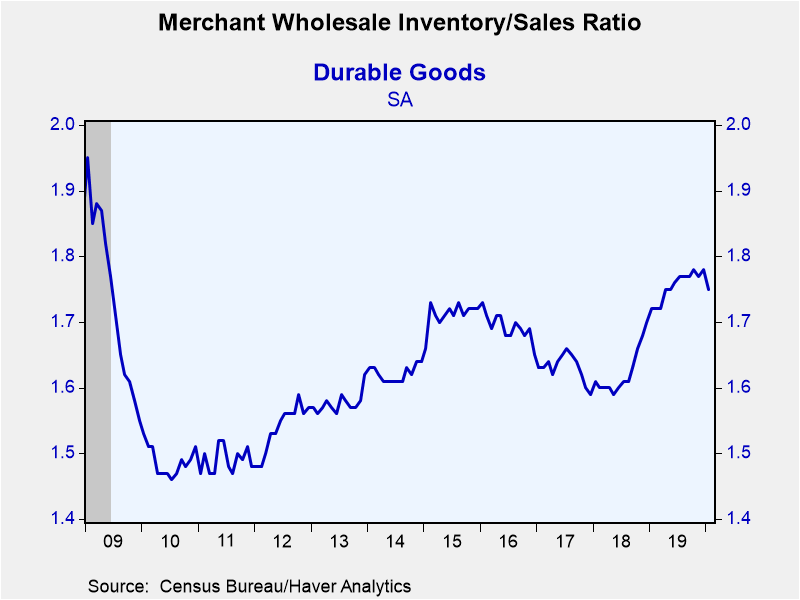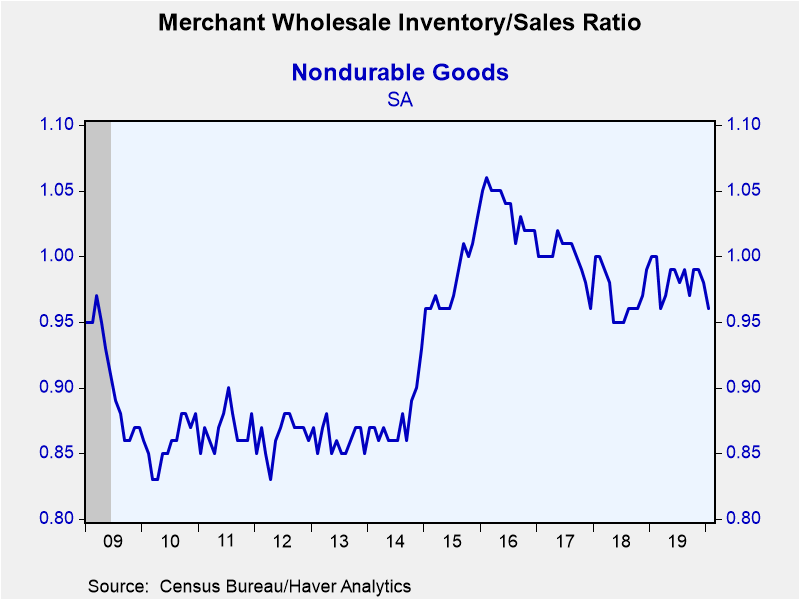 Global| Mar 06 2020
Global| Mar 06 2020Wholesale Inventories Fall but Sales Surge
by:Sandy Batten
|in:Economy in Brief
Summary
Wholesale inventories fell 0.4% m/m (+0.4% y/y) in January on top of a 0.3% m/m decline in December). Apparently reflecting the 0.2% m/m decline in the advance report, the Informa Global Markets Survey anticipated a 0.2% decline in [...]
Wholesale inventories fell 0.4% m/m (+0.4% y/y) in January on top of a 0.3% m/m decline in December). Apparently reflecting the 0.2% m/m decline in the advance report, the Informa Global Markets Survey anticipated a 0.2% decline in January. Inventory swings can have a meaningful impact on GDP growth. In 2019 Q4, a sharp slowdown in inventory investment subtracted 1.0%-points from overall real GDP growth. And with the January decline reinforcing the December drop, inventories are starting Q1 on track for another subtraction from overall GDP growth.
Inventories of both durable and nondurable goods experienced meaningful declines in January. Durable goods inventories decreased 0.3% (-0.1% y/y) in January after a 0.4% m/m drop in December. The January decline was widely spread across major categories and was led by a 2.3% m/m drop in inventories of computing equipment and a 1.4% m/m decline in metals inventories. Inventories of nondurable goods fell 0.5% m/m (+1.3% y/y) in January after a 0.1% m/m decrease in December. Declines in January were also widely spread across major categories, led by a 5.9% m/m drop in farm product inventories and a 5.8% m/m decline in in petroleum inventories.
In contrast, wholesale sales surprised to the upside in January, jumping up 1.6% (2.2% y/y) after having fallen 0.2% m/m in December, revised up from the initially reported 0.7% m/m decline. The Action Economics Forecast Survey had expected only a 0.1% m/m increase in sales in January. Sales of both durable and nondurable goods surged in January with durable sales up 1.6% m/m versus a 1.2% m/m decline in December and nondurable sales up 1.5% m/m on top of a 0.8% m/m rise in December.
Durable goods sales were up uniformly with no major category reporting a monthly decline in January. The strongest monthly gains were reported by computing equipment (+4.5% m/m) and machinery (+3.4% m/m). Sales of nondurable goods were more mixed with three of the nine major categories reporting declines and one an unchanged reading in January. The gains were led by a 5.5% m/m increase in petroleum sales.
With sales soaring and inventories falling, the inventory-to-sales (I/S) ratio at the wholesale level fell to 1.33 in January from 1.36 in December. This is the largest monthly decline in this ratio since June 2016. The ratio had been either 1.36 or 1.37 for the past eight months. The durable goods I/S ratio fell to 1.75 in January from 1.78 while the nondurable goods I/S ratio slid to 0.96 from 0.98. Declines were widespread across all industries with only two I/S ratios rising in January (hardware and drugs).
The wholesale trade figures are available in Haver's USECON database. The expectations figure for inventories is contained in the MMSAMER database. Expectations for sales are in the AS1REPNA database.
| Wholesale Sector - NAICS Classification (%) | Jan | Dec | Nov | Jan Y/Y | 2019 | 2018 | 2017 |
|---|---|---|---|---|---|---|---|
| Inventories | -0.4 | -0.3 | 0.1 | 0.4 | 2.1 | 7.3 | 3.3 |
| Sales | 1.6 | -0.2 | 0.9 | 2.2 | 0.6 | 6.7 | 6.7 |
| I/S Ratio | 1.33 | 1.36 | 1.36 | 1.35 (Jan '19) | 1.36 | 1.29 | 1.30 |
Sandy Batten
AuthorMore in Author Profile »Sandy Batten has more than 30 years of experience analyzing industrial economies and financial markets and a wide range of experience across the financial services sector, government, and academia. Before joining Haver Analytics, Sandy was a Vice President and Senior Economist at Citibank; Senior Credit Market Analyst at CDC Investment Management, Managing Director at Bear Stearns, and Executive Director at JPMorgan. In 2008, Sandy was named the most accurate US forecaster by the National Association for Business Economics. He is a member of the New York Forecasters Club, NABE, and the American Economic Association. Prior to his time in the financial services sector, Sandy was a Research Officer at the Federal Reserve Bank of St. Louis, Senior Staff Economist on the President’s Council of Economic Advisors, Deputy Assistant Secretary for Economic Policy at the US Treasury, and Economist at the International Monetary Fund. Sandy has taught economics at St. Louis University, Denison University, and Muskingun College. He has published numerous peer-reviewed articles in a wide range of academic publications. He has a B.A. in economics from the University of Richmond and a M.A. and Ph.D. in economics from The Ohio State University.










